Retro Replay Review
Gameplay
Worthy Opponent centers its appeal on a suite of a dozen lightweight, low-bandwidth mini-games, each designed for two-player head-to-head competition. From the serpentine twists of SnakePit to the strategic grid-locking of Quinte (a 19×19 “Connect 5”), the collection offers a pleasing variety of challenge types—some turn-based, others in real time—so that you’re never far from a fresh duel. Whether you’re outmaneuvering your friend in LazerMaze or jockeying for board control in Backgammon, each contest feels tightly tuned to the limitations and strengths of a text-mode environment.
(HEY YOU!! We hope you enjoy! We try not to run ads. So basically, this is a very expensive hobby running this site. Please consider joining us for updates, forums, and more. Network w/ us to make some cash or friends while retro gaming, and you can win some free retro games for posting. Okay, carry on 👍)
Connections are handled via direct computer-to-computer modem links, harking back to an era when “multiplayer” meant picking up the phone and dialing your opponent. Worthy Opponent’s internal terminal software keeps latency to a minimum and even supports live chat and taunting during gameplay, ensuring each match feels social and tense. On a 2400-baud or even 1200-baud connection, response times remain brisk, thanks to its ANSI text-mode graphics and efficient protocol, so you can focus on outthinking your rival rather than waiting for screens to redraw.
Replay value here is deceptively high. Each mini-game may be simple on the surface—think Checkers or Miniature Golf—but mastery requires learning subtle timing, positioning, and bluffing strategies unique to a two-player context. The absence of a weak computer opponent means every match is unpredictable and rewarding. As you progress from CannonBall Express to the treasure-hunting grids of TreasureQuest, you’ll find that even minor tweaks in your playstyle can swing victory or defeat in surprising ways.
Beyond the dozen core contests in version 1.9, version 2.0’s additions—CaveIn, TreasureQuest, and Miniature Golf—round out the roster with new mechanics that reward spatial reasoning and creative problem-solving. They slot in smoothly alongside stalwarts like ArmyAnts and MissileStrike, proving that a well-crafted mini-game doesn’t need high-resolution sprites to generate fierce rivalries or memorable moments of triumph (or gloating). For anyone who has ever wished for a portable, no-frills two-player toolkit, Worthy Opponent delivers on its name.
Graphics
At first glance, Worthy Opponent’s ANSI text-mode graphics might appear rudimentary compared to the VGA and SVGA standards of its day. Yet these simple characters and color blocks are precisely what make the experience snappy over old-school modems. Each mini-game uses symbolic representations—‘█’ for walls, ‘O’ for projectiles, ‘*’ for treasures—that remain clear and instantly recognizable even when frames update at only a few times per second. The design trades visual flair for responsiveness, and the sacrifice pays dividends in competitive play.
Despite its low-bandwidth constraints, the game employs a consistent palette and layout so that you quickly learn to parse each screen without mental friction. Whether you’re scanning the 19×19 grid of Quinte or checking your backgammon pips, the UI keeps critical information front and center. Colored text highlights active pieces, and simple animations—like a bouncing asterisk when a point is scored—add just enough life to keep the eye engaged without bogging down the connection.
In multiplayer matches, the split-screen ANSI display cleverly updates each player’s viewport independently, so both contestants see near-instant feedback on their own actions while still being notified when the opponent moves. This approach preserves the feeling of shared space without the full bandwidth demands of a graphical sprite engine. All things considered, the graphics do exactly what they need to: present clean, functional visuals that prioritize speed and clarity over pixel-perfect realism.
For players accustomed to modern 3D engines or richly textured 2D art, this may feel austere. But there’s a certain charm to the retro text aesthetic, especially for those who remember dialing in to Bulletin Board Systems or playing early online chess via CompuServe. Worthy Opponent embraces its era with pride, turning what could be seen as a limitation into a distinctive, almost artisanal, design choice.
Story
Worthy Opponent isn’t a story-driven title in the traditional sense. It offers no sprawling narrative campaign, character arcs, or branching dialogue trees. Instead, the “story” unfolds organically through the competitive sparks flying between two players. Each mini-game match becomes a micro-tale of cunning maneuvers, near-victories, and last-second comebacks—events you’ll relive in post-game bragging rights more than any scripted cutscene.
That said, each mini-game carries its own thematic flavor that fuels the imagination. In ArmyAnts, you lead swarms of insect warriors to encircle and outflank your opponent; in MissileStrike, you become a modern tactician launching ordnance in a digital warzone. Even Miniature Golf conjures an ersatz club and green within the confines of a text grid. These minimalist premises invite you to fill in the blanks, much like reading a short story from a few choice sentences.
Moreover, the in-play taunting and chat window create an emergent storyline unique to every pairing. A cheeky “nice try” typed mid-match or a dramatic “game over” declaration weaves a verbal narrative that outlives any static plot. In that way, Worthy Opponent feels more like a sporting event with dialogue than a conventional video game tale.
The retro context—late ’80s modems, ANSI graphics, peer-to-peer connections—adds a nostalgic backdrop that many modern players find enchanting. Even though there is no unifying quest or villain, the spirit of friendly rivalry and the social rituals of early online play give the software an unexpected depth of character and communal story potential.
Overall Experience
In an era flooded with sophisticated engines and immersive open worlds, Worthy Opponent stands out by doing exactly one thing and doing it very well: fostering two-player head-to-head competition over low-speed data links. The entire package feels like a carefully curated toolkit, where each mini-game slot seamlessly into the broader intention of sparking playful conflict and strategic experimentation.
Setting up a match requires little more than two DOS-based PCs, a pair of modems, and a phone line—or the equivalent in modern emulators and virtual null-modem connections. Once you’re online, setup is swift, and the internal terminal handles handshake, chat, and frame sync without fuss. For retro enthusiasts or hobbyists running BBS-style gatherings, this reliability is a major selling point; you can devote your time to playing instead of troubleshooting drivers or networking quirks.
There are some trade-offs. Without a solo mode or AI opponent, a second human player is always required. If you lack a partner able to reconnect reliably, the game’s value diminishes. Nor will those looking for a story-rich, single-player adventure find what they want here. But for anyone seeking a distilled, competitive experience—where bragging rights hinge on tactical nuance rather than graphical spectacle—Worthy Opponent delivers more engrossing moments per kilobyte than nearly any other title of its time.
Ultimately, Worthy Opponent captures the spirit of late-’80s online gaming: modest technical demands, nimble interfaces, and a vibrant do-it-yourself community ethos. For collectors, nostalgic players, or anyone curious about the roots of real-time multiplayer, it remains a worthwhile acquisition and a fascinating artifact of an era when every byte counted and every match felt like a mini-festival of wits.
 Retro Replay Retro Replay gaming reviews, news, emulation, geek stuff and more!
Retro Replay Retro Replay gaming reviews, news, emulation, geek stuff and more!
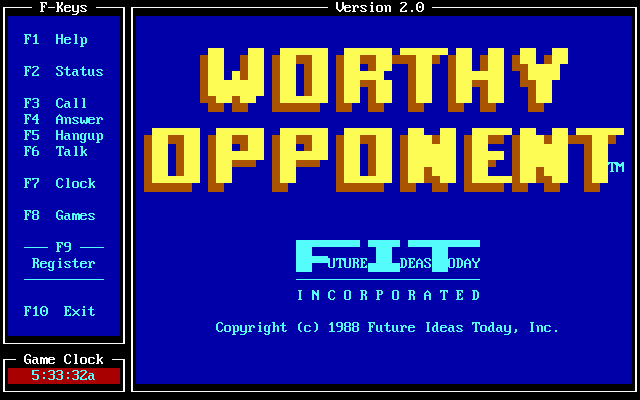
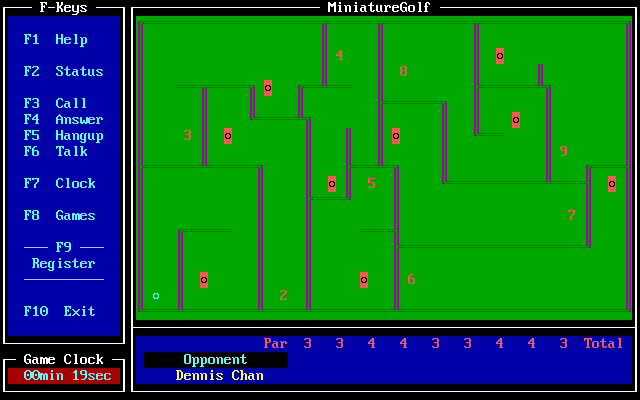
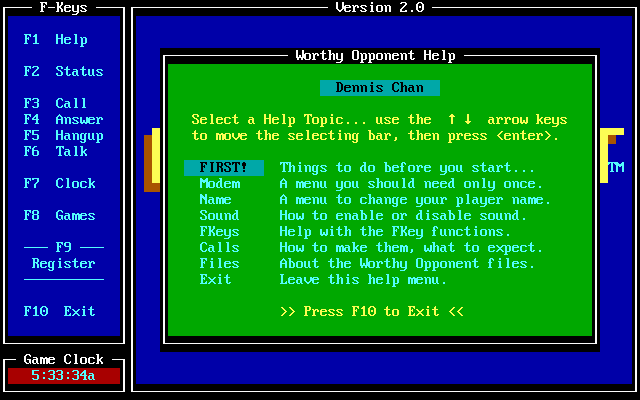
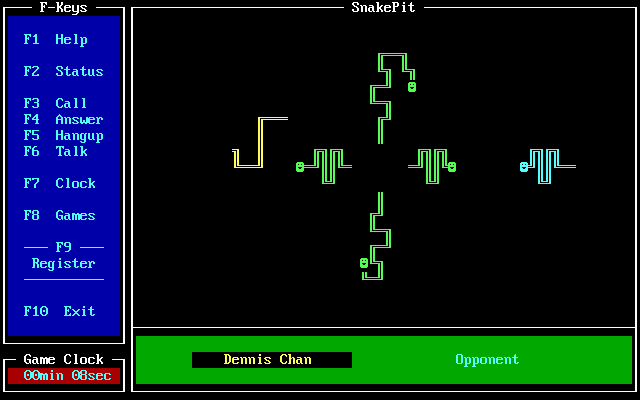
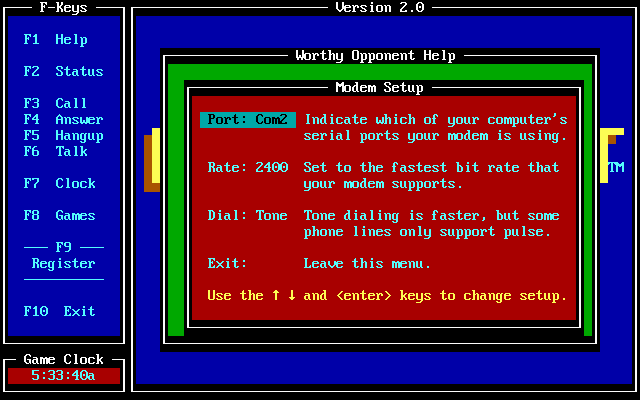
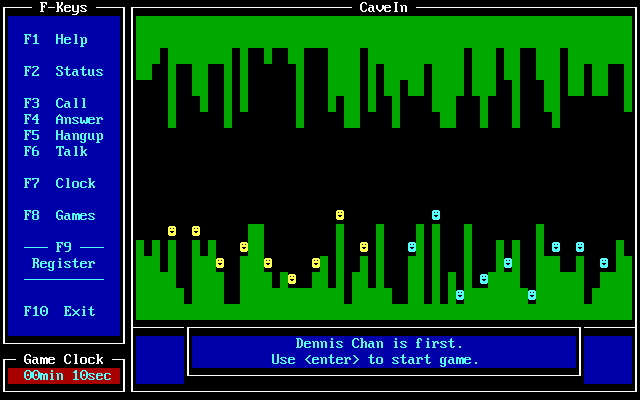



Reviews
There are no reviews yet.